Kanha, without a doubt, is one of the most famous wildlife destinations in India. Most tourists visit the place hoping to see a Tiger in the wild, and many of them do not go back disappointed. But for a more ardent wildlife enthusiast, Kanha can be equally rewarding if you are interested in watching birds. Here are some of my memorable birdwatching moments from Kanha.
The resident mixed hunting flock:
The lodge where I work is situated adjoining the buffer area of Kanha Tiger Reserve. Barring for a tiny wire fence for demarcation, the forest is uninterrupted on either side of the border. This allows several birds to visit the lodge grounds and move back into the buffer area without sparing a second thought. In fact, several of the birds reside in the lodge premises itself. Thus, birdwatching walks within the lodge can be greatly rewarding sometimes, especially if you come across a mixed hunting flock moving about.
It is not uncommon to see over twenty different species of birds moving around in a single flock. Some of them are present almost always. These include the Jungle Babblers, Greater Racket-tailed Drongos, Orange-headed Thrushes, Puff-throated Babblers, Black-hooded Orioles, Black-naped Monarchs, Brown-cheeked Fulvettas, Oriental Magpie-robins, Tickell’s Blue Flycatchers, Common Tailorbirds and some others. But occasionally you might find some highly unusual birds too. This list includes the Indian Nuthatch, Golden-fronted Leafbird, Indian Golden Oriole, Tawny-bellied Babbler, Indian Scimitar Babbler, White-rumped Shama, White-naped Woodpecker, Indian Paradise-flycatcher and few others.
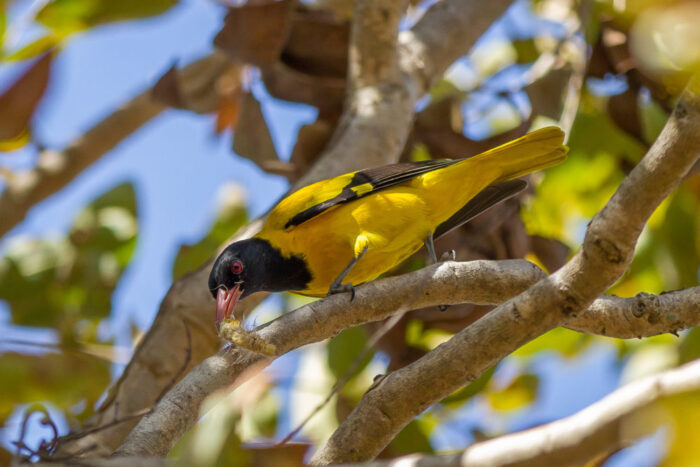
If you just spend sometime sitting at one place and observing the birds, you get to notice some really interesting behaviour. Most important and obvious of these behaviours is probably how these birds occupy different niches while foraging together. Puff-throated Babblers and Orange-headed Thrushes stick to the ground, foraging through the leaf litter. Greater Racket-tailed Drongos, Black-hooded Orioles and some others forage through the canopy, while White-naped Woodpeckers and Indian Nuthatches scan the barks for food. Some, like the Black-naped Monarchs, Tickell’s Blue Flycatchers and Indian Paradise-flycatchers, sometimes catch insects in flight. Others, such as Rufous Treepies and Golden-fronted Leafbirds are generalists, and will eat insects and fruits – whatever is conveniently available. But the one species which is probably the most versatile of all is the Jungle Babbler. Jungle Babblers are always present in greater numbers compared to any other species in mixed hunting parties, and move through the vertical layers of the forest to forage in the canopy, as well as the leaf litter, and they are not too fussy about what they get to eat either!
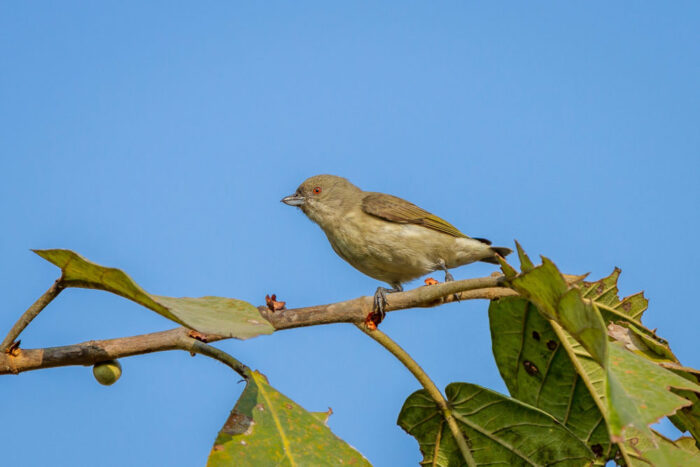
The Banyan buffet:
There is a big Ficus tree in our resort premises which bears fruits every January. This attracts many birds, big and small, from the surrounding areas. The first ones usually in attendance after the tree starts fruiting are the two species of barbets of Kanha – the larger Brown-headed Barbet and the smaller and more colourful Coppersmith Barbet. The gluttonous barbets gobble down whole fruits, barring the ones which they don’t like; such fruits are simply dropped to the ground.
Joining the barbets for breakfast every morning are several Oriental White-eyes and the tiny Thick-billed and Pale-billed Flowerpeckers (the latter being the smallest bird in India). The number of white-eyes present on the tree would sometimes, I feel, surpass a hundred. This super flock is actually comprised of several smaller flocks of white-eyes, evident by how these flocks visit and leave the tree in batches. For these smaller birds, the fruits are too big to swallow whole. So they simply nibble at them. But for these omnivorous birds, there is more than just the fruits to eat. Several insects getting attracted the fruiting tree are also on the menu.
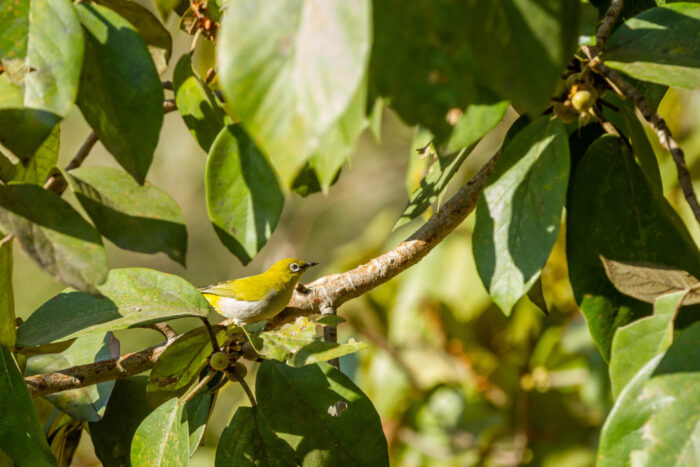
Other omnivorous birds visited the tree less regularly. This included the Rufous Treepie, Black-hooded Oriole, Golden-fronted Leafbird, Small Minivets and Black and Ashy Drongos. While all the above mentioned birds visited the tree early in the morning, one species preferred to visit the tree in the late morning or afternoon. This was the Indian Grey Hornbill. For some reason, the hornbills visited when the tree was not much crowed by the other species, fed in the shade of the giant canopy of the tree and left as quietly as they arrived.
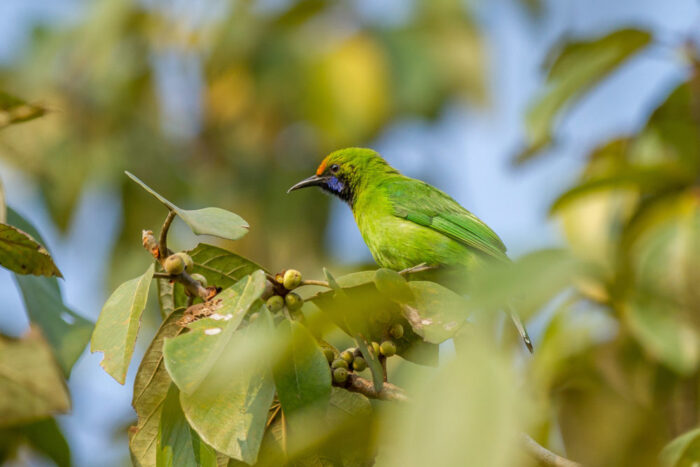
Feast for scavengers:
The plight of vultures in India since the dawn of this century is well-known. Thus, it makes me extremely happy to see vultures whenever and wherever possible. Some of the meadows in Kanha National Park are extremely good to see several species of vulture. In case there is a kill lying somewhere in the open, you can be sure that the vultures are not far away. White-rumped Vultures and Red-headed Vultures, both resident species, are regularly seen, although the former is present in much higher numbers compared to the latter.
On one occasion, I halted my vehicle to take a better look at a carcass of a Spotted Deer lying in a stream. Pretty soon the vultures started dropping in. This wake (flock of vultures) had mostly White-rumped and Indian Vultures. But soon enough, there was large, dark-coloured vulture circling down towards the kill. We identified this as the Cinereous Vulture, a super rare species in Kanha. Unfortunately, for the larger vulture, by the time it dropped in, the deer was finished by its smaller cousins, and the Cinereous Vulture had to stay hungry.
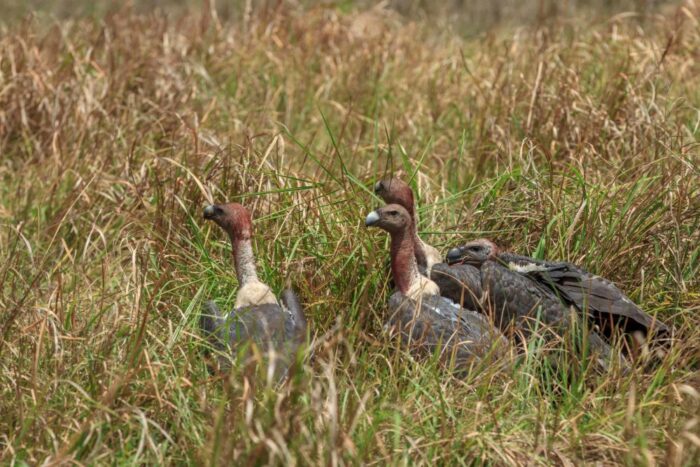
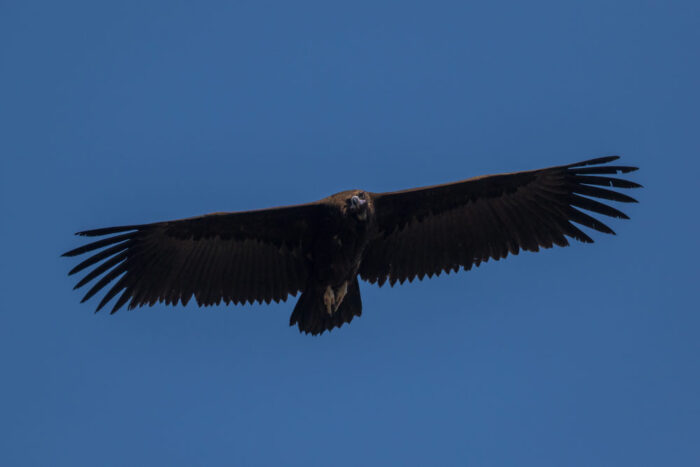
Nesting time:
Come summer, many resident birds of Kanha begin their amorous activities. The lodge premises being a sanctuary for many bird species, I get to see several of them while they are courting, breeding, building nests and raising a brood. There is a very good chance you might wake up to the sweet melodies of the Tickell’s Blue Flycatcher or Oriental Magpie-robin early in the morning, trying to impress a mate or claim a territory. On the flip side, there is chance you might be startled in your sleep by the shrill ‘I hate you’ calls of the Puff-throated Babbler. But this is a risk worth taking.
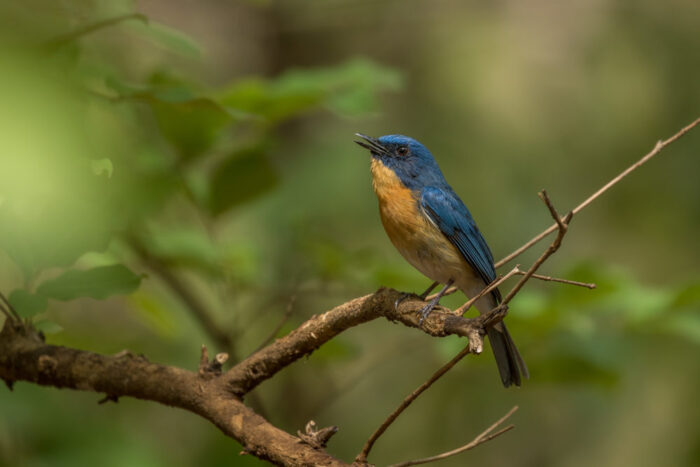
Once the intricacies of mating are out of the way, for many birds the laborious task of nest-building begins. Recently, I had an opportunity to observe a pair of Black-naped Monarchs building their nest as they selected a spot very close to my workplace. What astonished me was the speed with which they worked. The entire cup-shaped nest was build in just over a day! Also, it was surprising to see the amount of spider web they had to collect to bind their nest. I knew these birds use spider webs, but had never imagined that it would be in such copious amounts. For the tiny birds the hard work did not complete with the completion of the nest. They now defended the nest vigorously against squatters, including Red-vented Bulbuls and Brown-cheeked Fulvettas. Hopefully, their hard work pays off, and pretty soon there are baby monarchs flying around.
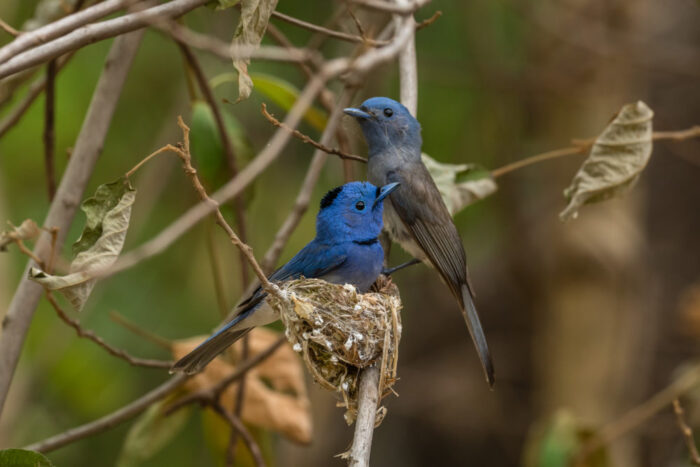
Kanha has been really rewarding for me as a birdwatcher. I have had some amazing sightings here so far, and I hope that this trend will continue, so that I have more stories to share.
Photos are fantastic.
Great article. Will connect with you & go birdwatching soon.
Amazing, very informative and well written article. Would love to go birding with you.
Thank you. I would love that as well. Hopefully, soon.
Greetings,
is it possible to get in touch with Mr Pranad . Would you mind sharing his email ID .
Best Regards
Sarfaraz Ahmad
pranadpatil@gmail.com